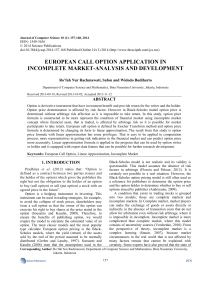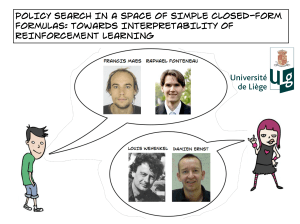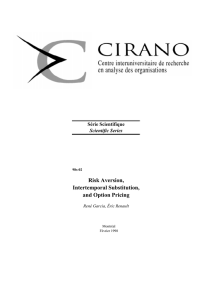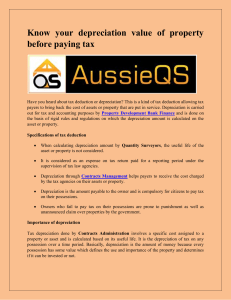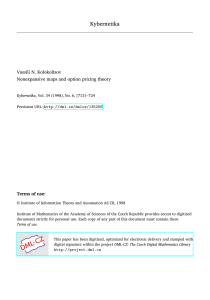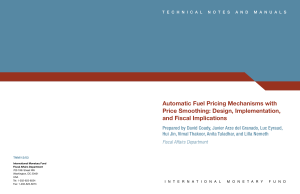http://ocean.kisti.re.kr/downfile/volume/ksiam/E1TAAE/2010/v14n4/E1TAAE_2010_v14n4_249.pdf
publicité
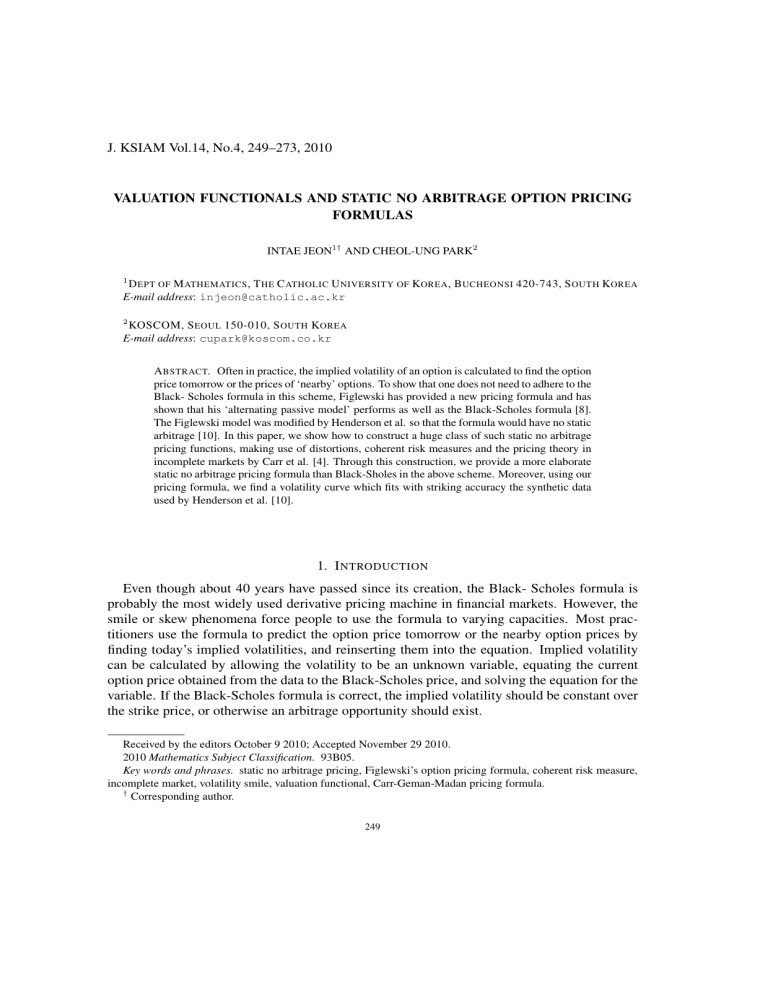
J. KSIAM Vol.14, No.4, 249–273, 2010 VALUATION FUNCTIONALS AND STATIC NO ARBITRAGE OPTION PRICING FORMULAS INTAE JEON1† AND CHEOL-UNG PARK2 1 D EPT OF M ATHEMATICS , T HE C ATHOLIC U NIVERSITY OF KOREA , B UCHEONSI 420-743, S OUTH KOREA E-mail address: [email protected] 2 KOSCOM, S EOUL 150-010, S OUTH KOREA E-mail address: [email protected] A BSTRACT. Often in practice, the implied volatility of an option is calculated to find the option price tomorrow or the prices of ‘nearby’ options. To show that one does not need to adhere to the Black- Scholes formula in this scheme, Figlewski has provided a new pricing formula and has shown that his ‘alternating passive model’ performs as well as the Black-Scholes formula [8]. The Figlewski model was modified by Henderson et al. so that the formula would have no static arbitrage [10]. In this paper, we show how to construct a huge class of such static no arbitrage pricing functions, making use of distortions, coherent risk measures and the pricing theory in incomplete markets by Carr et al. [4]. Through this construction, we provide a more elaborate static no arbitrage pricing formula than Black-Sholes in the above scheme. Moreover, using our pricing formula, we find a volatility curve which fits with striking accuracy the synthetic data used by Henderson et al. [10]. 1. I NTRODUCTION Even though about 40 years have passed since its creation, the Black- Scholes formula is probably the most widely used derivative pricing machine in financial markets. However, the smile or skew phenomena force people to use the formula to varying capacities. Most practitioners use the formula to predict the option price tomorrow or the nearby option prices by finding today’s implied volatilities, and reinserting them into the equation. Implied volatility can be calculated by allowing the volatility to be an unknown variable, equating the current option price obtained from the data to the Black-Scholes price, and solving the equation for the variable. If the Black-Scholes formula is correct, the implied volatility should be constant over the strike price, or otherwise an arbitrage opportunity should exist. Received by the editors October 9 2010; Accepted November 29 2010. 2010 Mathematics Subject Classification. 93B05. Key words and phrases. static no arbitrage pricing, Figlewski’s option pricing formula, coherent risk measure, incomplete market, volatility smile, valuation functional, Carr-Geman-Madan pricing formula. † Corresponding author. 249 250 INTAE JEON AND CHEOL-UNG PARK However, widely accepted is that neither of these is true. The arbitrage is risky and costly [8], and the implied volatility consistently shows smile or skew. If the Black-Scholes model is not accurate, the above prediction scheme should bear intrinsic errors or inconsistencies. For example, to predict the option prices tomorrow of different strike prices, people find the implied volatility of each option. Substituting the volatility into the Black-Scholes formula, applicants find the option price tomorrow of the same strike price. Since constant volatility is assumed over the strike price, this must be a misuse of the formula. Another example is finding the best fit for the implied volatility to all strike prices. Then, the predicted prices do not fit the data well. By showing that his ‘alternating passive model’ performs as well as the Black-Scholes model, Figlewski first indicated that, if the Black-Scholes formula is used in this way, the formula does not offer much advantage [8]. Henderson, Hobson, and Kluge (which we will refer to as HHK) modified Figlewski’s idea so that the formula would have no static arbitrage and confirmed the Figlewski’s results [10]. Moreover, they extended the model to include maturity and discussed the existence of an informationally passive benchmark for option pricing. However, they did not provide a pricing formula which performs better than the BlackScholes formula in most instances. One factor emerges as that their aim was not to find the best fit model, but rather to compare the Black-Scholes model against the simplest alternative model satisfying static no arbitrages. Another factor seems to be that they did not have sufficient static no arbitrage pricing formulas which indicated various shapes of volatility smiles and skews. Their one parameter family of static no arbitrage formulas shows only smile, while the implied volatility curve of the market data is close to skew, which must be a significant drawback of the model. The main purposes of our research are to find a different class of static no arbitrage pricing formulas, with various volatility shapes, and to make an attempt to find the best fit model. We also view the economical meaning or insight of the model in great detail, since the previous models do not seem to provide such an aspect. Subsequently, a huge class of static no arbitrage pricing formulas with plenty of smiles and skews can be found. Moreover, we find a volatility curve which fits strikingly well to the synthetic data used in HHK (see Figure 5). As pointed out in HHK, finding a static no arbitrage price formula is a ‘quite difficult’ task and the task should be even more difficult if the formula is to have some insight. We circumvent the situation via considering the distortion theory developed by Delbaen, Denneberg and Wang, the coherent risk measures by Arzner et al., and the pricing technique of Carr, Geman and Madan (which we will refer to as CGM) in incomplete markets [6], [13], [1], [4]. Our ideas rely on the assumption that the valuation measures of CGM can be generalized to valuation functional, as defined in Definition 4.1. CGM begins by defining an acceptable opportunity, which is drastically weakened in meaning for an arbitrage opportunity. Most people would accept an opportunity with mild risks, if the gains would adequately compensate for the costs. To test whether a trading strategy is acceptable, CGM introduced a set of measures (test and valuation measures) and associated floors, as well as non-positive numbers. An investment is acceptable if and only if the expected gain under each measure exceeds its associated floor. The main contribution by CGM is proof of the first and second fundamental theorems, STATIC NO ARBITRAGE OPTION PRICING FORMULAS 251 which demonstrates that under suitable conditions, the state pricing functions can be uniquely determined by a linear combination of the valuation measures. Inspired by the pricing scheme, we regard ρb (ST ) and −ρs (−ST ) as the valuations of the ST (T ≤ T̄ ) under the valuation measures of the single period model, where T̄ is a time horizon, ρb and ρs are valuation functionals, and S := {Sτ }t≤τ ≤T̄ is a stock price process. Assume there are two assets (one bond and one stock) and since there are two valuation measures, if the conditions for CGM are satisfied, there exists a unique wT between 0 and 1 such that n £ ¤ £ ¤o Ct,St (T, K) = e−r(T −t) wT ρb (ST − K)+ + (1 − wT )ρ̃s (ST − K)+ , n £ ¤ £ ¤o Pt,St (T, K) = e−r(T −t) wT ρ̃b (K − ST )+ + (1 − wT )ρs (K − ST )+ , where Ct,St (T, K) and Pt,St (T, K) are European call and put prices calculated at time t, assuming that the present time is t and thus St is deterministic. In this assumption, we do not need to introduce a conditional expectation in the formula. Here Pt,St (T, K) be found by a put-call parity,1 and ρ̃b (X) = −ρb (−X), ρ̃s (X) = −ρs (−X), and ( ¦ )+ = max(¦, 0). Note that the first formula holds for K = 0, i.e., h i Ct,St (T, 0) = St = e−r(T −t) wT ρb (ST ) + (1 − wT )ρ̃s (ST ) , which is a determining equation for wT . Suppose Sτ is geometric Brownian motion and ρb (X) = ρs (X) = E Q (X), where Q is the martingale measure. Then this becomes the Black-Scholes formula, and is, therefore, a generalization of Black-Scholes. In general, a valuation functional can not be expressed as an expectation of probability measures. Therefore, our valuations are different from those of CGM, and we can not apply their first and second fundamental theorems. However, those formulas still provide insights and the prices given above satisfy the static no arbitrage conditions under some minor conditions. Moreover, we can find adequate (ρb , ρs , S) triplets satisfying such conditions through this procedure. As an application, we provide specific examples of (ρb , ρs , S) in Section 5. One gives a 5-parameter family of static no arbitrage pricing formulas having various types of smiles and skews (see Figure 3 and Figure 4). By freezing all variables except one, we can produce a huge class of a one parameter family of static no arbitrage pricing formulas with which we can perform data analysis similar to that of Figlewski and HHK. We also provide a more simple example. This emerges as a 3-parameter family of pricing formulas with relatively fewer types of smiles. However, we are able to find a nearly optimal volatility curve which nicely fits the synthetic data derived in HHK (see Figure 5) through a typical optimization algorithm with three parameters. We did not repeat the work of Figlewski and HHK by performing the similar data analysis. Instead, we determined near optimal parameter values for the synthetic data HHK used. We well document the significance of this fitting in Section 6 of HHK, and we conclude that our model outperforms that of Black-Scholes in most instances. 1See the proof of Theorem 4.8 (iv). 252 INTAE JEON AND CHEOL-UNG PARK We organize this paper as follows. In Section 2, we introduce the static no arbitrage conditions which Merton derived. In Section 3, we introduce Figlewski (IG in short) and modified Figlewski (MIG in short) models. Section 4 is devoted to the construction of new static no arbitrage pricing formulas making use of distortions and coherent risk measures. We also provide some comparison results. In Section 5, we provide two concrete examples of pricing formula and discuss the shapes of smiles and skews. 2. S TATIC N O A RBITRAGE C ONDITIONS Let C and P be the prices of European call and put options at time t, respectively, on the stock price St (t: current time), with strike K, maturity T , and riskless rate r. We may think of C = Ct,St (T, K) and P = Pt,St (T, K) as functions of maturity and strike. Merton indicated the following conditions that any option price should satisfy to avoid static arbitrages [11]. (see also HHK) (i) Ct,St (T, K) is a decreasing, convex function of K. (ii) Ct,St (T, 0) = lim Ct,St (T, K) = St . K&0 (iii) For T1 ≥ T2 ≥ t, Ct,St (T1 , Ker(T1 −t) ) ≥ Ct,St (T2 , Ker(T2 −t) ). (iv) Put-call parity: Ct,St (T, K) − Pt,St (T, K) = St − Ke−r(T −t) . (v) lim Ct,St (T, K) = 0. K%∞ (vi) For T > 0, Ct,St (T, St er(T −t) ) > 0. Now, let the call price is a function of St , i.e., Ct,St (T, K) = CT,K (t, St ). (vii) CT,K (t, 0) = lim CT,K (t, St ) = 0. St &0 n o (viii) lim CT,K (t, St ) − (St − e−r(T −t) K) = 0. St %∞ Remark 2.1. The following condition is included in HHK. * CT,K (t, St ) is an increasing, convex function of asset price. However, if St is discontinuous or non-Markovian, then * may not hold.(see Bergman et al. [2].) Therefore, we omit this property for the static no arbitrage conditions, though , our models in Section 5 satisfy the property. 3. F IGLEWSKI (IG) AND M ODIFIED F IGLEWSKI (MIG) MODELS In this section, we briefly introduce the Figlewski and modified Figlewski models introduced by Figlewski and Henderson et al., respectively [8], [10]. Let C(T, K) = Ct,St (T, K) be the STATIC NO ARBITRAGE OPTION PRICING FORMULAS 253 0.25 0.25 0.2 0.2 Implied Volatility: g Implied Volatility: G price function of a European call option with strike price K and maturity T . Then r (St − Ke−r(T −t) )2 St − Ke−r(T −t) IG : C(T, K) = G + + , (3.1) 4 2 r (St − Ke−r(T −t) − g)2 St − Ke−r(T −t) − g MIG : C(T, K) = gSt + + , 4 2 where G and g are non-negative parameters. Notice that each of the formulas gives a one parameter family of price functions and MIG satisfies the static no arbitrage conditions, while IG does not. HHK also introduce time dependant pricing formulas: r (St − Ke−r(T −t) )2 St − Ke−r(T −t) IGT : C(T, K) = G(T − t) + + , (3.2) 4 2 r (St − Ke−r(T −t) − g(T − t))2 MIGT : C(T, K) = gSt (T − t) + 4 St − Ke−r(T −t) − g(T − t) + . 2 0.15 0.1 0.05 0 0.15 0.1 0.05 350 400 Strike Price 450 0 350 400 Strike Price 450 F IGURE 1. The three lines correspond to three different values of the parameter G and g. We omit the details of the analysis based on the real market data with reference to Figlewski and HHK. Figure 1 indicates how the implied volatilities for IG and MIG change as the parameters vary. It exhibits only smile, which is a considerable drawback of the models. HHK derived a quadratic regression of data and generated synthetic implied volatility data. One key observation emanates from a comparison between the synthetic data, Black-Scholes, IG and MIG (See Figure 2 ).2 In short, we may argue that the size of difference positively correlates 2In HHK, there is another model named Bachelier. We omit the model for simplicity. 254 INTAE JEON AND CHEOL-UNG PARK 0.25 Synth.data +++ BS IG 0.2 Implied Volatility MIG ..... __ −×−× 0.15 0.1 0.05 0 320 340 360 380 400 420 440 460 Strike Price F IGURE 2. Synthetic implied volatility data, and the corresponding best fit model implied volatilities (Black-Scholes, IG, and MIG) with the error sizes. It indicates that IG and MIG outperform Black-Scholes for lower strike prices, while they underperform for higher strike prices. Note that picking the pricing formula is based on the tractability and shape of the function rather than the theoretical background or economical meaning. We must note that if we are more flexible in adapting tractability, that is, if we do not hold strictly to the form of the explicit pricing function, we can produce a huge class of such a family of functions. Yet, we can deal with those functions by numerical calculation. To clarify this, we introduce the procedure for obtaining the IG and MIG pricing formulas. The appendix by HHK presents a detailed picture of this. Suppose C(T, K) satisfies (i), (ii), and (v) of static no arbitrage conditions. Let c = C(T, K)/St and k = Ke−r(T −t) /St . Then c = h(k) should be a strictly positive convex function with h(0) = 1 and h(∞) = 0. Since C(T, K) should be greater than or equal to the intrinsic value of the option, we have h(k) ≥ 1 − k. From (i), h is decreasing and convex, therefore there exists h−1 (c) = k, which is decreasing and convex. As a result, we have h−1 (c) ≥ 1 − c. Let h̃(c) := h−1 (c) − 1 + c. Then h̃ is a convex decreasing function with h̃(0) = ∞ and h̃(1) = 0. To find IG and MIG pricing formulas, we choose h̃(c) = F̃ /c and h̃(c) = (1 − c)M̃ /c, respectively, where F̃ and M̃ are some positive parameters. But the former does not satisfy the assumption: h̃(1) = 0, which is equivalent to h(0) = 1. Hence the IG model has a static arbitrage. To obtain the pricing formulas, we use the equation given by k = h−1 (c) = 1 − c + h̃(c). (3.3) STATIC NO ARBITRAGE OPTION PRICING FORMULAS 255 Solving equation (3.3) by c and substituting F̃ = G/St and M̃ = g/St , we have the IG and MIG pricing formulas (3.1), respectively. Note that the selection of such h̃ is for simplicity. Varying from IG and MIG, if we do not stick to simplicity too much, we can choose different functions, such as (1 − cα )G̃ h̃(c) = , (3.4) cβ where α and β are positive integers, and G̃ is some positive parameter. As can be seen from equation (3.3), we get (1 − cα )G̃ k =1−c+ . (3.5) cβ Then c is defined implicitly in the equation. We can still locate its value by a numerical scheme. However, selecting such functions in this way does not provide any intuition or economical meaning. Amongst the huge number of pricing functions, how can we find the optimal or nearly optimal one, with no insight? Consequently, it seems to be difficult to generalize the IG and MIG models. In the next section, we develop a new class of static no arbitrage pricing functions, making use of distortions and coherent risk measures and the pricing theory in incomplete markets by Carr et al. [4]. 4. VALUATION F UNCTIONALS AND THE S TATIC N O A RBITRAGE P RICING F ORMULA 4.1. Construction. Let (Ω, F, P) be a probability space where P represents the physical measure. For fixed T , let ST be the stock price realization at time T . Suppose there are two Carr-Geman-Madan valuation measures ν1 , ν2 , which generate valuation of ST as E ν1 (ST ) and E ν2 (ST ), respectively [4]. Then the matrix of asset valuation test measure C is defined by µ −r(T −t) ν ¶ e E 1 (ST ) e−r(T −t) E ν2 (ST ) C= , e−r(T −t) e−r(T −t) where r is the risk free interest rate. Note that, for any zero cost trading strategy α = (α1 , α2 ), α1 St + α2 e−r(T −t) = 0 implies α2 = −α1 St er(T −t) . Hence ¢ ¡ αC = α1 e−r(T −t) E ν1 (ST ) − St , e−r(T −t) E ν2 (ST ) − St , (4.1) Therefore, if e−r(T −t) E ν1 (ST ) > St , e−r(T −t) E ν2 (ST ) < St or e−r(T −t) E ν1 (ST ) < St , e−r(T −t) E ν2 (ST ) > St then there is no acceptable opportunity. By the first and second fundamental theorems there is a unique wT such that ³ £ ¤ £ ¤´ C(T, K) = e−r(T −t) wT E ν1 (ST − K)+ + (1 − wT )E ν2 (ST − K)+ , (4.2) where C(T, K) is the call option price with strike price K. 256 INTAE JEON AND CHEOL-UNG PARK We generalize this model using the following valuation functionals. Let M be the set of all measurable functions defined on Ω. Definition 4.1 (Valuation functional). A functional ρ : Mρ → R, is called a valuation functional, where Mρ ⊂ M is the domain of ρ, if (i) Mρ = {X ∈ M : ρ(X) < ∞ and ρ(−X) < ∞}, (ii) Separability: For any X ∈ Mρ , ρ(X) = ρ(X + ) + ρ(−X − ), (iii) Translation invariance: ρ(X + α) = ρ(X) + α, for any α ∈ R. (iv) Monotonicity: If X ≤ Y then ρ(X) ≤ ρ(Y ), for any X, Y ∈ Mρ . (v) Relevance: For any X ≥ 0 ∈ Mρ , if X is not identically zero, then ρ(X) > 0. (vi) Weak continuity: For any monotone sequence {Xn }n=1,2,3··· , if Xn converge to X in distribution and Xn , X ∈ Mρ , then ρ(Xn ) → ρ(X). The above conditions are relevant to prove that the resulting pricing formula satisfies the static no arbitrage conditions. Consider two valuation functionals ρb and ρs , which we may interpret as the buyer’s and seller’s valuational functional, respectively. Then the buyer’s price of a random variable XT at time T should be ρb (XT ), and the seller’s price should be −ρs (−XT ). Replacing E ν1 (·) and E ν2 (·) by ρb (·) and ρ̃s (·), where ρ̃(X) := −ρ(−X), the call option price in (4.2) becomes ³ £ ¤´ £ ¤ (4.3) C(T, K) = e−r(T −t) wT ρb (ST − K)+ + (1 − wT )ρ̃s (ST − K)+ . The put option price can, then, be found by a put-call parity, which becomes ³ £ ¤ £ ¤´ P (T, K) = e−r(T −t) wT ρ̃b (K − ST )+ + (1 − wT )ρs (K − ST )+ . (4.4) (i.e., if we set the put option price by (4.4), then it satisfies the put-call parity. See the proof of Theorem 4.8 (iv). ) This single period model can be generalized to a continuous time model by considering the fact that a stochastic process is just a one parameter family of random variables. Indeed, for any valuation functional ρ, let SP ρ := { X := {Xτ }t≤τ ≤T̄ : Xτ ∈ Mρ , for any τ ∈ (t, T̄ ]}. Definition 4.2 (Continuous extension). Define ϕ : (t, T̄ ] × SP ρ −→ R by ϕ(τ, X) = ρ(Xτ ). Then ϕ(τ, X) represents the value of the process X at time τ ∈ (t, T̄ ]. Now, consider any stochastic process which represents the underlying asset price. The process may not be Markovian. It needs to satisfy only three conditions. Assumption 4.3 (Underlying asset price process ). We assume that any positive stock price process S := {Sτ }t≤τ ≤T̄ satisfies the following conditions for any τ ∈ (t, T̄ ]: (i) Sτ has a continuous cdf, (ii) (Sτ − St er(τ −t) )+ is not identically zero, STATIC NO ARBITRAGE OPTION PRICING FORMULAS 257 £ (iii) (Regularity condition) Sτ is monotone increasing over St and for any K > 0, P Sτ ≥ ¤ K → 1 as Sτ % ∞. Then we can generalize (4.3) and (4.4) by ³ ¡ ¢ ¡ ¢´ C(τ, K) = e−r(τ −t) wτ ϕb τ, (S − K)+ − (1 − wτ )ϕs τ, −(S − K)+ (4.5) ³ ´ £ ¤ £ ¤ = e−r(τ −t) wτ ρb (Sτ − K)+ + (1 − wτ )ρ̃s (Sτ − K)+ , ³ £ ¤ £ ¤´ P (τ, K) = e−r(τ −t) wτ ρ̃b (K − Sτ )+ + (1 − wτ )ρs (K − Sτ )+ , for τ ∈ [t, T̄ ]. As we mentioned in section 1, we assume that the present time t and thus St is deterministic. Remark 4.4. If all valuation functionals are given by the expectations under the unique martingale measure Q and {Sτ }t≤τ ≤T̄ is a geometric Brownian motion, then ¡ ¢ Ct,St (τ, K) = e−r(τ −t) E Q (Sτ − K)+ , ¡ ¢ Pt,St (τ, K) = e−r(τ −t) E Q (K − Sτ )+ , which recover Black-Scholes formulas. Remark 4.5. In the above pricing scheme, all we need in relation to the stock price process is the marginal density at each time τ . The path property of the process is not important. The process may be even non-Markovian and the market model may be incomplete. As we mentioned in Section 1, we will not discuss the validity of the first and second fundamental theorems in our case. Instead, we will concentrate on indicating that the formulas satisfy the conditions for the static no arbitrage. To do this, we start to define some preliminary concepts. Definition 4.6. Let V be the class of all valuation functionals. For any positive stock price process S := {Sτ }t≤τ ≤T̄ ∈ SP ρb ∩ SP ρs , and ρb , ρs ∈ V, we say (ρb , ρs , S) is a consistent triplet, if for any K ≥ 0 and for any t ≤ τ ≤ T̄ , ρb ((Sτ − K)+ ) ≤ ρ̃s ((Sτ − K)+ ) and there exists a one parameter family of wτ (0 < wτ < 1) such that ¡ ¢ St = e−r(τ −t) wτ ρb (Sτ ) + (1 − wτ ) ρ̃s (Sτ ) . (4.6) Definition 4.7. Suppose a consistent triplet (ρb , ρs , S) satisfies the following conditions, then we say the triplet is proper. ¡ ¢ ¡ ¢ (a) For any t ≤ T ≤ T̄ , ρb (ST − K)+ , ρ̃s (ST − K)+ are decreasing convex functions of K. (b) For any K ≥ 0, C(T, Ker(T −t) ) is an increasing function of T , where C(T, K) is the associated pricing function in (4.5). 258 INTAE JEON AND CHEOL-UNG PARK Theorem 4.8. Let the consistent triplet (ρb , ρs , S) be proper. Then C(T, K) and P (T, K) in (4.5) satisfy the static no arbitrage conditions. Proof. The proof will be completed by checking the eight conditions in Section2. (i) C(T, K) is decreasing and convex over K from (a). (ii) Since (ST − 1/n)+ converges monotonously to ST as n → ∞, by (iv) and (vi) in Definition 4.1, ρb (ST − K)+ → ρb (ST ) as K & 0. Similarly, ρ̃s (ST − K)+ → ρ̃s (ST ) as K & 0. Hence, by (4.6), lim C(T, K) = St . K&0 (iii) By (b), C(T, Ker(T −t) ) is increasing over T . (iv) Put-call parity : Let w1 = wT , w2 = 1 − wT . Since ST − K = (ST − K)+ − (ST − K)− , (4.7) C ( T, K) − P (T, K) ³ £ ¤´ £ ¤ = e−r(T −t) w1 ρb (ST − K)+ + w2 ρ̃s (ST − K)+ ³ £ ¤´ £ ¤ −e−r(T −t) w1 ρ̃b (K − ST )+ + w2 ρs (K − ST )+ ³ £ £ ¤´ ¤ = e−r(T −t) w1 ρb (ST − K)+ − ρ̃b (K − ST )+ ³ £ £ ¤´ ¤ +e−r(T −t) w2 ρ̃s (ST − K)+ − ρs (K − ST )+ ³ £ £ ¤´ ¤ = e−r(T −t) w1 ρb (ST − K)+ + ρb −(K − ST )+ ³ £ £ ¤´ ¤ +e−r(T −t) w2 ρ̃s (ST − K)+ + ρ̃s −(K − ST )+ ³ £ £ ¤´ ¤ = e−r(T −t) w1 ρb (ST − K)+ + ρb −(ST − K)− ³ £ ¤ £ ¤´ +e−r(T −t) w2 ρ̃s (ST − K)+ + ρ̃s −(ST − K)− ³ £ ¤´ ¡ ¢ £ ¤ by (ii) of Definition 4.1 = e−r(T −t) w1 ρb ST − K + w2 ρ̃s ST − K ³ ´ ¡ ¢ by (iii) of Definition 4.1 = e−r(T −t) w1 ρb (ST ) + w2 ρ̃s (ST ) − (w1 + w2 ) K = St − Ke−r(T −t) . + (v) Since (S monotonously to 0 as n → ∞, by (iv) and (vi) in Definition ¡ T −n) converges ¢ 4.1, ρb (ST − K)+ → ρb (0) = 0 as ¡K % ∞, where ¢ the equality can be obtained + from (ii) in Definition 4.1. Similarly ρ̃s (ST − K) → 0 as K % ∞. Therefore lim C(T, K) = 0. K%∞ STATIC NO ARBITRAGE OPTION PRICING FORMULAS 259 (vi) Since (ST − St er(T −t) )+ is not identically zero, by the relevance condition, C(T, St er(T −t) ) > 0. £ (T, K) = C (t, S ). Since ρ (S ) ≥ ρ (ST − (vii) For any T and any K > 0, let C t T,K T t,S b b t ¤ £ ¤ + + K) and ρ̃s (ST ) ≥ ρ̃s (ST − K) , by (4.5) and (4.6), St ≥ CT,K (t, St ) ≥ 0. Therefore, CT,K (t, St ) converges to 0 as St & 0. (viii) From put-call parity, CT,K (t, St ) − (St − Ke−r(T −t) ) = PT,K (t, St ), where PT,K (t, St ) = Pt,St (T, K) is © given by (4.5). Using ª the regularity condition in Assumption 4.3, for any x > 0, P (K − ST )+ ≥ x → 0 as St % ∞. Therefore, (K − ST )+ goes to X ≡ 0 monotonously in distribution as St % ∞. By weak continuity in Definition 4.1, ρ̃b (Xn ) → ρ̃b (0) = 0. Similarly, ρs (Xn ) → 0. n Therefore, PT,K (t, St ) converges to 0 as St % ∞, i.e., lim CT,K (t, St ) − (St − St %∞ o −r(T −t) e K) = 0. ¤ 4.2. Distortion type static no arbitrage pricing formula. In this section, we introduce a class of valuation functionals defined by a function g, called distortion. For simplicity, as we explain in the previous section, we will define only single period model. The continuous time extension is similar to that in Definition 4.2. The idea reverts back to Delbaen’s convex game and recent developments of insurance theories (see [5], [6], [7], [13].) Later, we will choose specific g’s to construct a concrete family of static no arbitrage pricing formulas. Definition 4.9. Let (Ω, F, P) be a probability space and g : [0, 1] → [0, 1] a continuous and strictly increasing function with g(0) = 0 and g(1) = 1. Define a monotone set function ν := g ◦ P. We call ν a distorted probability and g the corresponding distortion. Remark 4.10. In general, g may not be continuous and may not be strictly increasing. For our purpose, the above definition is enough. Choquet defined a non-necessarily additive integration, which is called the Choquet integral [5]. We call this a distortion type valuation functional with respect to the distorted probability ν. Definition 4.11 (Distortion type valuation functional). Let ν be a distorted probability. For any non-atomic random variable X ∈ M, we define ρ(X) by Z 0 Z ∞ ¡ ¢ ρ(X) := ν(X ≥ x) − 1 dx + ν(X ≥ x)dx, −∞ and let Mρ 0 := {X : ρ(X) < ∞ and ρ(−X) < ∞, X is non-atomic}. 260 INTAE JEON AND CHEOL-UNG PARK A simple calculation shows Z Z ∞ ρ(X) = 0 ¡ ¢ ν(X ≥ x) − 1 dx ν(X ≥ x)dx + 0 Z −∞ 0¡ Z ∞ ¢ ν(−X ≤ y) − 1 dy ∞ Z0 ∞ Z ∞³ £ ¤´ £ ¤ 1 − g 1 − P{−X ≥ y} dy = g P{X ≥ x} dx − Z0 ∞ Z0 ∞ £ ¤ £ ¤ = g P{X ≥ x} dx − g̃ P{−X ≥ y} dy, = ν(X ≥ x)dx − 0 0 where g̃(u) := 1 − g(1 − u), for u ∈ [0, 1]. Note that g̃ is a distortion such that (i) g̃(0) = 1 − g(1) = 0 and g̃(1) = 1 − g(0) = 1, (ii) g̃ is an increasing function. Therefore, we have Z Z ∞ £ ¤ £ ¤ g P{X + ≥ x} dx − g̃ P{X − ≥ x} dx Z0 ∞ Z ∞ 0 £ ¤ £ ¤ = g F̄X + (x) dx − g̃ F̄X − (x) dx, ∞ ρ(X) = 0 (4.8) 0 where F̄X (x) := P{X ≥ x}. Proposition 4.12. If ρ is a distortion type valuation functional, then it is a valuation functional. Proof. (i) (Separability) For any Y ∈ Mρ , note that Z ∞ Z ∞ £ ¤ £ ¤ ρ(Y ) = g F̄Y + (x) dx − g̃ F̄Y − (x) dx. 0 0 ¤ R∞ £ Replacing Y = 0 g F̄X + (x) dx. Since ρ̃(Y ) = −ρ(−Y ), Z ∞ Z ∞ £ ¤ £ ¤ ρ̃(Y ) = − g F̄(−Y )+ (x) dx + g̃ F̄(−Y )− (x) dx Z0 ∞ Z ∞0 £ ¤ £ ¤ = − g F̄Y − (x) dx + g̃ F̄Y + (x) dx. by X + , we obtain ρ(X + ) 0 0 Replace Y by X − , Z − ρ̃(X ) = 0 ∞ £ ¤ g̃ F̄X − (x) dx. Therefore, from (4.8) ρ(X) = ρ(X + ) − ρ̃(X − ) = ρ(X + ) + ρ(−X − ). STATIC NO ARBITRAGE OPTION PRICING FORMULAS 261 (ii) (Translation invariance) For any X ∈ Mρ and for any α ∈ R, Z ∞ £ © ª¤ g P (X + α)+ ≥ x dx ρ(X + α) = 0 Z ∞ £ © ª¤ − g̃ P (X + α)− ≥ x dx Z ∞0 £ © ª¤ = g P X ≥ x − α dx 0 Z ∞ £ © ª¤ − g̃ P − X ≥ x + α dx 0 Z ∞ Z 0 £ © ª¤ £ © ª¤ = g P X ≥ t dt + g P X ≥ t dt 0 Z −α Z 0 £ © ª¤ £ © ª¤ − g̃ P − X ≥ t dt − g̃ P − X ≥ t dt 0 α Z 0 n £ © ª¤ £ © ª¤o = ρ(X) + g P X ≥ t + g̃ P X ≤ t dt ∞ −α 0 n Z = ρ(X) + £ © ª¤ ³ £ © ª¤´o g P X ≥t + 1−g P X ≥t dt −α = ρ(X) + α. (iii) (Monotonicity) The proof of Monotonicity is trivial. (iv) (Relevance) For X(≥ 0) ∈ M£ρ , if X is not¤identically zero, then there is x > 0 such that P{X ≥ x} > 0. Thus g P{X ≥ x} > 0. Since g and F̄X are continuous, ρ(X) > 0. (v) (Weak continuity) For any non-negative monotone sequence {Xn } ⊂ Mρ which converges to X ∈ Mρ in distribution, we have P{Xn ≥ x} → P{X ≥ x} for all x that are continuity points of F̄X , i.e., since discontinuity points are at most countably many, £ P{X ≥ x} → P{X ≥ x} almost everywhere. Since g is continuous, g P({X n n ≥ ¤ £ ¤ x} → g P{X ≥ x} almost everywhere. First, £ we assume¤{Xn }£ is increasing. ¤ Then, P{Xn ≥ x} ≤ P{X ≥ x}. Therefore, g P{Xn ≥ x} ≤ g P{X ≥ x} , since g is increasing. By Dominated convergence £ theorem, we ¤ get ρ(X £ n ) → ρ(X). ¤ Decreasing case is similar, since Xn ≤ X1 and g P{Xn ≥ x} → g P({X ≥ x} . Finally, this result can be extended easily to any monotone sequence in Mρ . ¤ Theorem 4.13. Let ρb , ρs be distortion type valuation functionals with corresponding distortions gb and gs , respectively. Suppose (ρb , ρs , S) is a consistent triplet, gb , gs are differentiable, ∂ and C(T, Ker(T −t) ) ≥ 0. Then C(T, K) and P (T, K) in (4.5) satisfy the static no arbi∂T trage conditions. In this case, we call the equations distortion type pricing formulas. Proof. By Theorem 4.8, it suffices to show that our consistent triplet (ρb , ρs , S) is proper. 262 INTAE JEON AND CHEOL-UNG PARK (a) For 0 ≤ T ≤ T̄ , Z ∞ ¡ ¢ £ ¤ + ρb (ST − K) = gb F̄(ST −K)+ (x) dx Z0 ∞ £ ¤ gb F̄ST (x) dx = K Z K = − ∞ and Therefore, ¡ ¢ ρ̄s (ST − K)+ = − Z K ∞ £ ¤ gb F̄ST (x) dx, £ ¤ g̃s F̄ST (x) dx. ¡ ¢ £ ¤ ∂ ρb (ST − K)+ = −gb F̄ST (K) < 0, ∂K £ ¤ ¡ ¢ ∂ ρ̃s (ST − K)+ = −g̃b F̄ST (K) < 0. ∂K Moreover, since gb , g̃s are increasing, ¡ ¢ ¤´ ∂ ³ £ ∂2 + (S − K) = − ρ F̄ (K) g T S b b T ∂K 2 ∂K £ ¤ ¡ ¢ = −gb0 F̄ST (K) · − fST (K) > 0, and £ ¤ ¡ ¢ ¡ ¢ ∂2 ρ̃s (ST − K)+ = −g̃b0 F̄ST (K) · − fST (K) > 0, 2 ∂K where fST is the pdf of ST . ∂ C(T, Ker(T −t) ) ≥ 0, C(T, Ker(T −t) ) is an increasing function of T. (b) Since ∂T ¤ 4.3. Coherent type static no arbitrage pricing formula. Another class of examples of the valuation functionals can be obtained from the coherent risk measure. Let (Ω, F, P) be a probability space. Let L∞ be the set of all bounded random variables defined on Ω. Artzner et al. introduced a risk measure which they called a coherent risk measure [1]. Definition 4.14 (Coherent risk measure). A functional φ : L∞ → R, is called a coherent risk measure if it satisfies (i) Translation invariance : φ(X + α) = φ(X) − α (ii) Sub-additivity: φ(X1 + X2 ) ≤ φ(X1 ) + ρ(X2 ) (iii) Positive homogeneity: φ(λX) = λφ(X) for all λ ≥ 0 (iv) Monotonicity: X ≤ Y implies φ(X) ≥ φ(Y ). Instead of the above definition, we sometimes use the supermodular functional introduced by Delbaen [6]. This satisfies super additivity. STATIC NO ARBITRAGE OPTION PRICING FORMULAS 263 Definition 4.15 (Supermodular functional). A functional ρ : Mρ = L∞ → R, is called a supermodular functional if ρ(X) = −φ(X) for some coherent risk measure φ. That is, it satisfies (i) (ii) (iii) (iv) Translation invariance : ρ(X + α) = ρ(X) + α Super-additivity: ρ(X1 + X2 ) ≥ ρ(X1 ) + ρ(X2 ) Positive homogeneity: ρ(λX) = λρ(X) for all λ ≥ 0 Monotonicity: X ≤ Y implies ρ(X) ≤ ρ(Y ). Definition 4.16 (Coherent type valuation functional). If a supermodular functional satisfies conditions (ii),(v) and (vi) in Definition 4.1, then we call it a coherent type valuation functional. Remark 4.17. Coherent type valuation functional is a valuation functional. Proposition 4.18. Let ρ be a distortion type valuation functional with a differentiable distortion g. If g is a convex distortion, then ρ is a coherent type valuation functional. Proof. The proof is in Chapters 5 and 6 of [7] and [12] with different notations. ¤ 4.4. Comparisons between the IG, MIG and Distortion type static no arbitrage model. In this section we examine whether the MIG model can be expressed as distortion type pricing formulas. It turns out that IG, MIG formulas are not distortion type. Moreover, they are not of the moderate type, which is defined as follows. Definition 4.19. If a valuation functional ρ satisfies the additional condition (vii) to Definition 4.1, then we call ρ a moderate valuation functional, where (vii) Pseudo translation invariance: for any random variable X ≥ 0 with continuous cdf at 0, ρ(X · 1{X≥h} − h · 1{X≥h} ) = ρ(X) − h + o(h). Theorem 4.20. Suppose (ρb , ρs , S) is a consistent triplet, and ρb , ρ̃s are moderate valuation functional. Let C(K) = Ct,St (K, T ) be the associated call option price with maturity T . Then dC ¯¯ = −e−r(T −t) ¯ dK K=0 264 INTAE JEON AND CHEOL-UNG PARK Proof. C(h) − C(0) h = = = £ ¤ 1 −r(T −t) ³ e wT ρb (ST − h)+ h ´ £ ¤ + (1 − wT ) ρ̃s (ST − h)+ − St er(T −t) £ ¤ 1 −r(T −t) ³ e wT ρb (ST − h) · 1{ST ≥h} h ´ £ ¤ + (1 − wT ) ρ̃s (ST − h) · 1{ST ≥h} − St er(T −t) © ª 1 −r(T −t) ³ e wT ρb (ST ) − h + o(h) h ´ © ª + (1 − wT ) ρ̃s (ST ) − h + o(h) − St er(T −t) (by (vii) of Definition 4.19) ´ 1 −r(T −t) ³ e wT ρb (ST ) + (1 − wT ) ρ̃s (ST ) − h + o(h) − St er(T −t) = h Letting h → 0, C(h) − C(0) converges to −e−r(T −t) . h ¤ Corollary 4.1. MIG pricing function can not be derived from a moderate valuation functional. r (S0 − Ke−r(T −t) − g)2 S0 − Ke−r(T −t) − g + and g is positive, Proof. Since C = gS0 + 4 2 ³ dC ¯¯ 1 ´ −r(T −t) ¯¯ (S0 − Ke−r(T −t) − g)/2 − e = − p ¯ ¯ dK K=0 K=0 2 gS0 + (S0 − Ke−r(T −t) − g)2 /4 2 ³ ´ 1 −r(T −t) (S0 − g)/2 − = − p e 2 2 gS0 + (S0 − g) /4 2 > −e−r(T −t) . This completes the proof. ¤ Corollary 4.2. MIG pricing function is not a distortion type formula. Proof. It is not difficult to show that the distortion type is moderate. ¤ The remaining of this section is devoted to explain a distortion type pricing model in the view point of the construction of IG and MIG in Section 3. Consider a distortion type call option price function as follows. ³ £ ¤ £ ¤´ Ct,St (T, K) = e−r(T −t) wT ρb (ST − K)+ + (1 − wT )ρ̃s (ST − K)+ , (4.9) STATIC NO ARBITRAGE OPTION PRICING FORMULAS where wT ∈ (0, 1). Then equation (4.9) becomes Z ∞ ¡ ¢ C(T, K) = e−r(T −t) Gw ◦ F̄(ST −K)+ (x)dx Z0 ∞ ¡ ¢ −r(T −t) = e Gw ◦ F̄ST (x)dx K Z = St − e−r(T −t) 0 K 265 (4.10) ¡ ¢ Gw ◦ F̄ST (x)dx, where Gw := wT gb + (1 − wT )g̃s and gb , g̃s are corresponding distortions. The last equality holds because limK&0 C(T, K) = St . Now we set c = C(T, K)/St , k = Ke−r(T −t) /St , and sT = ST e−r(T −t) /St . Then equation (4.10) becomes Z k ¡ ¢ c = ϕ(k) = 1 − Gw ◦ F̄sT (x)dx ≥ 1 − k. (4.11) 0 It is easy to see that ϕ(0) = 1 and ϕ(∞) = 0. Suppose gb and g̃s are differentiable. Differentiate both sides of (4.11) with k and differentiate twice with k, then we obtain ¢ ¡ dc/dk = − Gw ◦ F̄sT (k) < 0 and d2 c/dk 2 = −Gw0 (F̄sT (k))(−fsT (k)) > 0, where fsT is the pdf of sT . Therefore c = ϕ(k) is decreasing and convex. In the next section, we provide methods of how to construct concrete and tractable static no arbitrage pricing formulas. Using the methods, we can obtain huge classes of static no arbitrage pricing formulas. Though it may be difficult to deal with them analytically, numerical analysis is not difficult. 5. A PPLICATION 5.1. An example which exibits various shapes of smiles and skews. Consider the cdf Ψ(x) of Student’s t, which is defined by Ψ(x) := B ν ν 2 +x2 ( ν2 , 12 ) 2B( ν2 , 12 ) , for x ≤ 0, and Ψ(x) := 1 − Ψ(−x), for x > 0, where ν > 2, B(x, y)Z is a beta function and Bu (x, y) is an incomplete beta function defined by u 1 Bu (x, y) = tx−1 (1 − t)y−1 dt. For λ > 0, we choose a distortion g such that B(x, y) 0 g(u) := Ψ(Ψ−1 (u) − λ) 1, u ∈ [0, 1]. 1This type of distortion with normal cdf is given by Wang for different purposes [13]. 266 INTAE JEON AND CHEOL-UNG PARK Note that g(0) = 0, g(1) = 1 and g is increasing.2 Since Ψ(−x) = 1−Ψ(x) and Ψ−1 (1−t) = −Ψ−1 (t), we have g̃(u) := 1 − g(1 − u) = Ψ(Ψ−1 (u) + λ), u ∈ [0, 1]. Consider the triplet (ρgb , ρgs , S) with corresponding distortions gb (u) = Ψ(Ψ−1 (u) − λB ) and gs (u) = Ψ(Ψ−1 (u) − λS ). Let ρgb = ρb and ρgs = ρs . Note that gb (u) = Ψ(Ψ−1 (u) − λB ) ≤ Ψ(Ψ−1 (u) + λS ) = g̃s (u). Hence, for any K ≥ 0 and any T ∈ [t, T̄ ], Z ∞ £ ¤ £ ¤ + ρb (ST − K) = gb F̄(ST −K)+ (x) dx Z0 ∞ £ ¤ ≤ g̃s F̄(ST −K)+ (x) dx 0 £ ¤ = ρ̃s (ST − K)+ . Let S := {Sτ }t≤τ ≤T̄ be a stock price process given by Sτ = hτ (ξ), (5.1) ν+1 (1 + x2 /ν)− 2 where ξ is a Student’s t with pdf ψ(x) = √ , ν > 2, and νB( ν2 , 21 ) ( St eaξ+r(T −t) : ξ ≤ 0, hT (ξ) = r(T −t) St (b ξ + 1) e : ξ > 0, (5.2) where a, b are positive constants. The reason we pick hT (ξ) with this shape is for simplicity and we can easily show that for any T ∈ (t, T̄ ], ST ∈ Mρb ∩ Mρs , ST has a continuous cdf, and (ST − St er(T −t) )+ is not identically zero. It also satisfies the regularity condition. With suitable constraints on λB , λS , which we will discuss later, the associated European call price function C(T, K) is given by ³ £ ¤´ £ ¤ + + −r(T −t) , C(T, K) = e wT ρb (ST − K) + (1 − wT )ρ̃s (ST − K) Z ∞ ³ Z ∞ £ ¤ £ ¤ ´ g̃s F̄ST (x) dx , = e−r(T −t) wT gb F̄ST (x) dx + (1 − wT ) K K which becomes Z ∞n ¡ ¢ ¡ ¢o −r(T −t) e wT Ψ Ψ−1 [F̄ST (x)] − λB + (1 − wT )Ψ Ψ−1 [F̄ST (x)] + λS dx, (5.3) K ¡ ¢ ¡ ¢ where wT = ρ̃s (ST ) − St er(T −t) / ρ̃s (ST ) − ρb (ST ) . 2Since g is not convex, it may not be a coherent type valuation functional. STATIC NO ARBITRAGE OPTION PRICING FORMULAS 267 + Since hT : R → R+ is a continuous positive increasing function, there exist h−1 T :R →R such that ¢ 1¡ log(x/St ) − r(T − t) : 0 < x ≤ St er(T −t) , −1 hT (x) = a1 ¡ (5.4) ¢ xe−r(T −t) − St : x > St er(T −t) , bSt and F̄ST (x) = P{ST ≥ x} = P{hT (ξ) ≥ x} (5.5) = P{ξ ≥ hT−1 (x)} = Ψ(−h−1 T (x)). Using (5.4) and (5.5), the associated European call price function (5.3) becomes (i) 0 ≤ K ≤ St er(T −t) : C(T, K) = e −r(T −t) h Z wT Z + (1 − wT ) (ii) K > St er(T −t) : C(T, K) = e −r(T −t) Z St er(T −t) K Ψ(α̃)dx + (1 − wT ) K h Z wT K Ψ(β)dx + (1 − wT ) i Ψ(β̃)dx , ∞ St er(T −t) Z ∞ (5.6) St er(T −t) Z St er(T −t) ∞ Ψ(β)dx Ψ(α)dx + wT ∞ i Ψ(β̃)dx , (5.7) K where ¢ 1¡ log(x/St ) − r(T − t) − λB a ¢ 1¡ α̃ = − log(x/St ) − r(T − t) + λS a ¢ 1 ¡ −r(T −t) β = − xe − St − λB bSt ¢ 1 ¡ −r(T −t) β̃ = − xe − St + λS . bSt α = − Simple substitution yields, (i) 0 ≤ K ≤ St : Z C(T, Ker(T −t) ) = wT Z St K Ψ(γ)dx + wT + (1 − wT ) Z ∞ Ψ(δ)dx St St K Ψ(γ̃)dx + (1 − wT ) (5.8) Z ∞ St ¢ Ψ(δ̃ dx, 268 INTAE JEON AND CHEOL-UNG PARK (ii) K > St : Z C(T, Ker(T −t) ) = wT Z ∞ K Ψ(δ)dx + (1 − wT ) ∞ Ψ(δ̃)dx, (5.9) K where 1 γ = − log(x/St ) − λB a 1 γ̃ = − log(x/St ) + λS a ¢ 1 ¡ δ = − x − St − λB bSt ¢ 1 ¡ δ̃ = − x − St + λS . bSt ∂ C(T, Ker(T −t) ) ≥ 0 to indicate that the associated By Theorem 4.13, we should check ∂T pricing function satisfies the static no arbitrage conditions. Letting K & 0 in (5.8), we have a condition Z ∞ h Z St Ψ(γ)dx + wT Ψ(δ)dx (5.10) St = wT 0 + (1 − wT ) Z 0 St St Z Ψ(γ̃)dx + (1 − wT ) i Ψ(δ̃)dx . ∞ St Note that wT can be determined by (5.10), i.e., £ R St ¤ R∞ 0 Ψ(γ̃)dx + St Ψ(δ̃)dx − St wT = £ R St ¤ £ R St ¤. R∞ R∞ Ψ(γ̃)dx + Ψ( δ̃)dx − Ψ(γ)dx + Ψ(δ)dx 0 St 0 St (5.11) Therefore, wT is constant for T . Hence C(T, Ker(T −t) ) is not T dependent. Taken together, C(T, K) satisfies the static no arbitrage conditions. Using simple substitution of variables, the condition (5.10) can be expressed by Z −λB Z ∞ h i −aλB −au e Ψ(u)du + b Ψ(u)du (5.12) 1 = wT ae −∞ −λB Z h aλS + (1 − wT ) ae Z ∞ λS e −au Ψ(u)du + b λS i Ψ(u)du . −∞ Let D = {λB , λS , a, b, ν, wT } be the set of parameters. By (5.12), one element of D is determined by the others. Now we provide various shapes of smile and skew by selecting specific parameters. See Figure 3 and Figure 4. Though this example provides a rich class of volatility shapes, due to the complexity, it is difficult to determine parameters. The next example provides a relative ease in determining parameters, though it does not have ample volatility smile structure. STATIC NO ARBITRAGE OPTION PRICING FORMULAS 0.2 269 0.2 0.18 0.18 (1) (2) 0.16 Implied Volatility Implied Volatility 0.16 (3) 0.14 0.12 (1) (2) 0.14 (3) 0.12 (1) a=0.07 b=0.065 (1) a=0.08 b=0.08 (2) a=0.07 b=0.06 (2) a=0.07 b=0.06 0.1 0.1 (3) a=0.07 b=0.055 (3) a=0.06 b=0.06 0.08 350 400 Strike Price 0.08 450 350 400 Strike Price 450 F IGURE 3. Various Smile curves: St = 381.7, r = 0.0629, T − t = 0.5, ν = 3, λS = 1, wT = 0.8, (a) Left figure(⇓):(1)λB = 0.11, (2)λB = 0.1986, (3)λB = 0.3044, (b) Right figure(⇓):(1)λB = 0.2575, (2) λB = 0.1986, (3)λB = 0.1355 0.24 (1) 0.24 0.22 (2) 0.22 0.2 (3) Implied Volatility Implied Volatility 0.2 0.18 0.18 (1) 0.16 0.16 0.14 0.14 (2) (3) (1) a=0.2 (1) a=0.16 b=0.055 b=0.05 (2) a=0.16 b=0.05 (2) a=0.16 b=0.05 0.12 0.12 (3) a=0.13 b=0.05 350 400 Strike Price 450 (3) a=0.16 b=0.045 350 400 Strike Price 450 F IGURE 4. Various Skew curves: St = 381.7, r = 0.0629, T − t = 0.5, ν = 30, λS = 2, wT = 0.6687, (a) Left figure(⇓):(1)λB = 0.0552, (2)λB = 0.1966, (3)λB = 0.3393 (b) Right figure(⇓):(1)λB = 0.2679, (2) λB = 0.1966, (3)λB = 0.1205 270 INTAE JEON AND CHEOL-UNG PARK 5.2. An example of near optimal fitting for the synthetic data used in Henderson et al. Consider the cdf Φ(x) of standard normal, defined by Z x 1 2 √ e−t /2 dt . (5.13) Φ(x) := 2π −∞ For λ > 0, we choose a distortion g such that g(u) := Φ(Φ−1 (u) − λ), u ∈ [0, 1]. Note that g(0) = 0, g(1) = 1 and g is increasing convex. Since Φ(−x) = 1 − Φ(x) and Φ−1 (1 − t) = −Φ−1 (t), we have g̃(u) = Φ(Φ−1 (u) + λ), u ∈ [0, 1]. Consider the triplet (ρgb , ρgs , S) with corresponding distortions gb (u) = Φ(Φ−1 (u) − λB ) and gs (u) = Φ(Φ−1 (u) − λS ). Since gb , gs are convex, by Proposition 4.18, ρgb and ρgs are coherent type valuation functionals. Let ρgb = ρb and ρgs = ρs . Note that gb (u) = Φ(Φ−1 (u) − λB ) ≤ Φ(Φ−1 (u) + λS ) = g̃s (u). Hence, for any K ≥ 0 and any T ∈ (t, T̄ ], £ ¤ £ ¤ ρb (ST − K)+ ≤ ρ̃s (ST − K)+ . Let S := {Sτ }t≤τ ≤T̄ be a stock price process given by Sτ = St eεa+r(τ −t) , (5.14) where ε is a standard normal random variable and a is some positive parameter. Then we can easily show that ST ∈ Mρb ∩ Mρs , ST has a continuous cdf, and (ST − St er(T −t) )+ is not identically zero. It also satisfies the regularity condition. With suitable constraints on λB , λS , which we will discuss later, the associated European call price function C(T, K) is given by ³ £ ¤´ £ ¤ + + −r(T −t) , C(T, K) = e wT ρb (ST − K) + (1 − wT )ρ̃s (ST − K) Z ∞ ³ Z ∞ £ £ ¤ ´ ¤ g̃s F̄ST (x) dx , = e−r(T −t) wT gb F̄ST (x) dx + (1 − wT ) K K which becomes Z ∞n ¡ ¢ ¡ ¢o −r(T −t) e wT Φ Φ−1 [F̄ST (x)] − λB + (1 − wT )Φ Φ−1 [F̄ST (x)] + λS dx, (5.15) K ¡ ¢ ¡ ¢ where wT = ρ̃s (ST ) − St er(T −t) / ρ̃s (ST ) − ρb (ST ) . Note that F̄ST (x) = P{ST ≥ x} = P{St eaε+r(T −t) ≥ x} © log(x/St ) − r(T − t) ª = P ε≥ a ³ − log(x/S ) + r(T − t) ´ t = Φ . a (5.16) STATIC NO ARBITRAGE OPTION PRICING FORMULAS Using (5.16), the associated pricing function (5.15) becomes Z ∞ ³ h ´ − log(x/St ) + r(T − t) C(T, K) = e−r(T −t) wT Φ − λB dx a Z ∞K ³ ´ i − log(x/St ) + r(T − t) +(1 − wT ) Φ + λS dx . a K Simple substitution yields, Z ∞ ³ ´ h − log(x/St ) r(T −t) − λB dx C(T, Ke ) = wT Φ a K Z ∞ ³ ´ i − log(x/St ) +(1 − wT ) Φ + λS dx . a K Therefore, Z ∞ ³ ´ h − log(x/St ) − λB dx St = C(T, 0) = wT Φ a 0 Z ∞ ³ ´ i − log(x/St ) +(1 − wT ) Φ + λS dx . a 0 271 (5.17) (5.18) (5.19) ∂ By Theorem 4.13, we should check ∂T C(T, Ker(T −t) ) ≥ 0 to show the associated pricing function satisfies the static no arbitrage conditions. Note that wT can be determined by (5.19), i.e., ¢ R∞ ¡ Φ − log(x/St )/a + λS dx − St 0 ¢ ¢ . R∞ ¡ wT = R ∞ ¡ (5.20) 0 Φ − log(x/St )/a + λS dx − 0 Φ − log(x/St )/a − λB dx Therefore, wT is constant for T . Hence C(T, Ker(T −t) ) is not T dependent. In total, C(T, K) satisfies static no arbitrage conditions. Using simple substitution of variables, (5.19) becomes Z ¢ ∞ −au ¡ −aλB aλS a wT e + (1 − wT )e e Φ(u)du − 1 = 0. (5.21) −∞ There are four parameters, λB , λS , wT , and a, one of which is determined by the others through (5.21). Let x = (λB , λS , wT , a). Define f (x) by X© ª2 f (x) := C M arket (T, Ki ) − C(T, Ki ; x) , (5.22) i C M arket (T, K where i ) and C(T, Ki ; x) are the observed market price and the predicted model price, respectively, of the option with strike price Ki . Let Z ¡ ¢ ∞ −au h(x) = a wT e−aλB + (1 − wT )eaλS e Φ(u)du − 1, −∞ and g(x) = (−λB , −λS , wT − 1, −a). 272 INTAE JEON AND CHEOL-UNG PARK Then the determining of parameters becomes the optimization problem given by minimize subject to f (x) h(x) = 0, g(x) ≤ 0, where 0 = (0, 0, 0, 0).1 0.25 Synth.data +++ ..... __ BS IG 0.2 −×−× MIG Implied Volatility Our model −− 0.15 0.1 0.05 0 320 340 360 380 400 420 440 460 Strike Price F IGURE 5. Comparison of implied volatilities (Synthetic data, Our model, Black-Scholes, IG, and MIG). Parameters for our model: λB = 2.9999476, λS = 0.419358, a = 0.065, wT = 0.143432, St = 381.7, r = 0.0629, T − t = 0.5. Figure 5 indicates our near optimal fitting result for the synthetic data used in HHK. To obtain this result, we use the steepest descent method and numerical integration. Section 6 of HHK well documents the significance of this fitting. 1In Definition 4.6, w should satisfy 0 < w < 1. However, the condition w < 1 is enough to have static no t t t arbitrage price. STATIC NO ARBITRAGE OPTION PRICING FORMULAS 273 For example, IG and MIG more appropriately fit for lower strike prices. Our model almost perfectly matches the synthetic data. The analysis with real market data and the hedging issues will be a subsequent study. Acknowledgment. I. Jeon was supported by the Research Fund, 2006 of The Catholic University of Korea. R EFERENCES [1] P. Artzner, F. Delbaen, J. Eber and D. Heath, Coherent measures of risk , Mathematical Finance, 9 (1999), 203–228. [2] Y. Z. Bergman, B. D. Grundy and Z. Wiener, General Properties of Option Prices, Journal of Finance, 51 (1996), 1573–1610. [3] F. Black and M. Scholes, The Pricing of Options and Corporate Liabilities, Journal of Political Economy, May-June 81 (1973), 637–659. [4] P. Carr, H. Geman and D. Madan, Pricing and Hedging in Incomplete Markets, Journal of Financial Economics, 62 (2001), 131–167. [5] G. Choquet, Theory of Capacities, Ann. Inst. Fourier(Grenoble), 5 (1953), 131–295. [6] F. Delbaen, Coherent risk measures on general probability spaces, in Advances in Finance and StochasticsEssays in Honour of Dieter Sondermann, K. Sandmann and P. J. Schonbucher, eds. New York: Springer, 2002. [7] D. Denneberg, Non-Additive Measure and Integral, Dordercht, The Netherlands: Kluwer Academic Publishers, 1994. [8] S. Figlewski, Assessing the Incremental Value of Option Pricing Theory relative to an “Informationally Passive” Benchmark, Journal of Derivatives, Fall (2002), 81–96. [9] S. Figlewski and T. Green, Market Risk and Model Risk for a Financial Institution Writing Options, Journal of Finance, 53(4) (1999), 1465–1499. [10] V. Henderson, D. Hobson and T. Kluge, Is There an Informationally Passive Benchmark for Option Pricing Incorporating Maturity?, Quantitative Finance, 7(1) (2007), 75-86. [11] R. Merton, Theory of Rational Option Pricing, Bell Journal of Economics and Management Science, 4 (1973), 141–183. [12] D. Schmeidler, Integral Representation without additivity, Proceedings of the American Mathematical Society, 97(2) (1986), 255–261. [13] S. Wang, A Class of Distortion Operators for Pricing Financial and Insurance Risks, The Journal of Risk and Insurance, 67(1) (2003), 15–36.


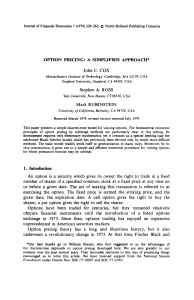
![[faculty.baruch.cuny.edu]](http://s1.studylibfr.com/store/data/008196527_1-00094098ced89faa02164e141a3c1389-300x300.png)

